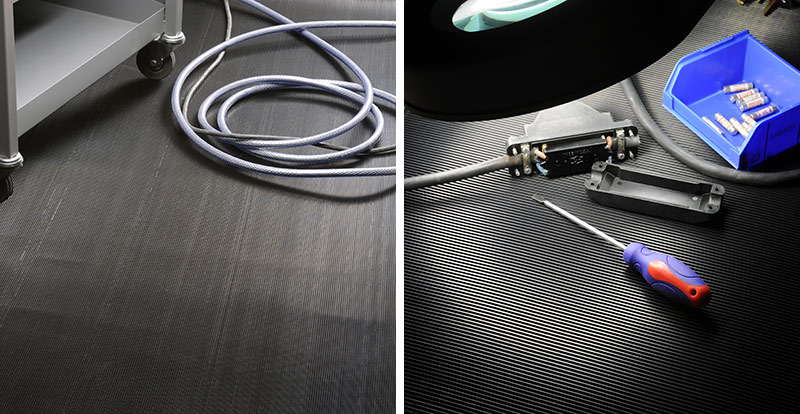Do you need to control static in your business?
A static build-up can be dangerous, Here's why and where you may need to create an ESD protected area or workstation within your industry.
Controlling static may not be the first thing on your mind in a production environment. But if it isn't, perhaps it is something to bear in mind.
Static charge is invisible, which unwittingly can make it a big risk. A build-up of static can be incredibly damaging to sensitive and expensive components and equipment, potentially causing irreparable damage and therefore, monetary loss to your business.
Static is essentially a build-up of electrostatic discharge. If this build up is unexpectedly released, which can occur simply by an unearthed person touching an electrical component, it can cause catastrophic damage. It is imperative that this risk is removed, particularly in environments where high-tech products are manufactured.

Earthing, or grounding, are the technical terms for the method in which electrostatic discharge (ESD) is dissipated. Electrical components can build up a high-induced voltage, thus ESD equipment should be bonded between 1 and 10 ohms.
There are many anti-static products on the market that can provide static guard. We look at those which work particularly well within an industrial setting.
How to remove static from your workplace in ten steps.
- Install an ESD Workbench - All ESD workbenches from ESE Direct are supplied with an earthing wire and earthing bolt. These must be installed by a qualified electrician via the electrical service duct on the rear of the bench. ESD workbenches have versatility in their design too. There are two main types of workbench, general purpose and cantilever, the latter is favourable if the user will be seated. They can be manufactured to accommodate a multitude of situations with height adjustments and extension benches available for expanding your area for work on electrical equipment.
- Select your work surface - Lamstat or Norostat? For a harder work surface opt for Lamstat, it provides a solid surface for cutting and if chemicals are involved, is more resilient than Norostat. Norostat is a type of rubberised vinyl which offers a softer non slip surface. Great for use with delicate components.
- Earth Leads - These are the foundation of any ESD environment and an accessory you simply can't do without when looking to limit static problems in your workplace. The ground lead connects to your workbench and is the starting block to creating your protective area.
- Louvre Panels - Added to the rear of your workbench, an ESD louvre panel will create an excellent facility for storing parts and components used alongside ESD protected picking containers.
- Picking Containers - Electro-conductive storage bins simply hang onto a louvre panel and provide the perfect vessel for storage of small parts and metal objects. Made from hard-wearing polypropylene, they contain an anti-static additive for assurance of the safety of your sensitive parts.
- Storage Drawers - an additional storage facility for your workbench. These can be fitted beneath the bench. It's important to note that free-standing or mobile drawer units are not suitable for an ESD environment as they cannot be earthed. The drawers need to be directly attached to the underside of the workbench. Essentially, they then become part of the workbench unit and are therefore grounded through the earth lead connected to the bench.
- Shelving - For even more storage potential, locate a shelf above the work surface, mounted on the upright rear support posts. As with the storage drawers, the shelf becomes an integral part of the workbench and is therefore earthed via the ground lead. The shelves are available with Lamstat or Norostat surfaces.
- Wrist straps - In order for an environment to be fully ESD safe, it's not just the equipment that requires earthing. Humans do too. The amount of static build up on a human being can be considerable and is almost certainly the most damaging if not properly dealt with. So to effectively dissipate static electricity from the human body, one way is via a static control wrist band. These are resistant up to 1 megohm
- Anti-static ESD matting - This particular type of matting is specially designed with a high level of electrical resistance and should meet IEC61340-4-1 Category DIF standards. When a user is stood on the mat they are protected to a safe resistance. Therefore the mat will dissipate charge and keep that charge beneath the specified limit. ESD mats should pass the ISO 6356 test. This test ensures that 95% of the measured test points of a floor surface will be resistance to ground of less than 109 ohms. It's good to know, a selection of ESD mat also contains anti-fatigue properties to help reduce pressure and strain on lower limbs for the user, increasing wellbeing and productivity.
- ESD Chairs - If your preferred working position is to be seated it's essential that your chair is earthed and comfortable. Fully adjustable, ergonomic chairs are ideal for best posture.
Once you have invested in the best ESD anti-static products, check them on a regular basis. This of course requires discipline, but it's important as all it takes is a loose connection, or for someone to have inadvertently removed a vital part of your ESD equipment for your electro-static protected area to be compromised. So, as a preventative measure thorough testing procedures should be put in place.
When maintaining your ESD equipment in terms of cleaning, be careful which types of cleaning you products use. For instance, products containing silicone can form a layer on your ESD matting which then creates a barrier which can interfere with the grounding. There are specially designed products for cleaning ESD equipment on the market. As a precaution it's advisable to display signage in ESD protected areas as reminders to always follow procedure.
Effective ESD protected area management is fundamental to the success of electronics manufacturing and repair businesses. Hopefully this article has helped you to identify several key elements that you can adopt in your workplace to improve productivity and profitability.

Author Bio - Debs
Digital marketer, social media, content writer, musician, sloth-lover, tea-drinker.





